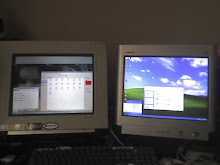After upgrading to kernel 5.4.1 in Slackware64-current, elilo did not work at all, even after running eliloconfig. I realized that the latest Slackware64-current ISO (http://slackware.uk/people/alien-current-iso/slackware64-current-iso/) was running grub as the bootloader. I decided to give grub a try. These are the steps I followed:
1) Uninstall elilo (removepkg elilo)
2) Removed all files under /boot/efi/EFI/elilo (create a backup before removing the folder, in case you need the files afterwards)
3) Run "grub-mkconfig -o /boot/grub/grub.cfg" to create the required boot entries
4) Reboot and test
Regards,
F. Bobbio C.
Monday, December 23, 2019
NVIDIA GeForce GTX 1050 In Slackware64-current
Update 12-30-2019: My DisplayLink based USB 3.0 docking station is working nicely with the NVIDIA driver now. I had to modify the /etc/rc.d/rc.local file and add the following lines:
# Load evdi after reboot
modprobe evdi
cd /usr/lib64/displaylink
./DisplayLinkManager &
# Create missing nvidia device nodes after reboot
/usr/bin/nvidia-modprobe -c 0 -u
I am also using the latest versions of xorg-server, x-org-server-xephyr, xorg-server-xnest and xorg-server-xvfb. I documented all the changes here: http://docs.slackware.com/talk:howtos:hardware:displaylink
Update 12-26-2019: My DisplayLink based USB 3.0 docking station did not play nicely with the NVIDIA driver. I am using it without the xorg.conf file and the Intel chip. I will use the xorg.conf file and NVIDIA driver in situations when I have to use the HDMI port and the Intel driver without the xorg.conf file when using the USB 3.0 docking station
My old and trusty Toshiba laptop "died" and I needed to replace it. I purchased an Acer Nitro 5 AN515-53-52FA laptop with an Intel Core i5-8300H Processor 2.3GHz and an NVIDIA GeForce GTX 1050 4GB GDDR5 video card. The Intel built-in video driver worked out of the box on Slackware64-current (kernel 5.4.6), but the NVidia driver could not install and work properly. At the time of this writing, the latest version was 440.44 (https://www.nvidia.com/Download/driverResults.aspx/156086/en-us). The Intel driver did not display the HDMI port at all when running xrandr, only eDP-1-1. I read various pages of tutorials and gathered enough information to fix the issue
I repackaged nvidia-kernel (http://www.slackbuilds.org/repository/14.2/system/nvidia-kernel/) and nvidia-driver (http://www.slackbuilds.org/repository/14.2/system/nvidia-driver/) using the latest .run file. Once the driver and kernel packages were ready, I installed them and rebooted, with some issues. I rebooted again, and pressed "e" at the grub screen and added "3" at the line starting with "linux" and pressed F10 to boot into runlevel 3 (multiuser, no GUI, just cli, with networking)
I edited the following files:
/etc/X11/xorg.conf
Section "ServerLayout"
Identifier "layout"
Screen 0 "nvidia"
Inactive "intel"
EndSection
Section "Files"
EndSection
Section "InputDevice"
Identifier "Keyboard0"
Driver "kbd"
EndSection
Section "InputDevice"
Identifier "Mouse0"
Driver "mouse"
Option "Protocol" "auto"
Option "Device" "/dev/psaux"
Option "Emulate3Buttons" "no"
Option "ZAxisMapping" "4 5"
EndSection
Section "Device"
Identifier "nvidia"
Driver "nvidia"
BusID "PCI:1:0:0"
EndSection
Section "Device"
Identifier "intel"
Driver "modesetting"
BusID "PCI:0:2:0"
EndSection
Section "Screen"
Identifier "nvidia"
Device "nvidia"
Option "AllowEmptyInitialConfiguration" "Yes"
EndSection
Section "Screen"
Identifier "intel"
Device "intel"
EndSection
/usr/share/sddm/scripts/Xsetup
xrandr --setprovideroutputsource modesetting NVIDIA-0
xrandr --auto
I also removed all files under /var/lib/sddm
rm -R /var/lib/sddm/*
Upon reboot in runlevel 4, I was able to view port HDMI-0 and plugged in a TV with an HDMI cable. The resolution was 1920 x 1080. The audio also worked in the TV and the laptop was able to use the HDMI port for audio
I hope this helps someone
Regards,
F. Bobbio C.
# Load evdi after reboot
modprobe evdi
cd /usr/lib64/displaylink
./DisplayLinkManager &
# Create missing nvidia device nodes after reboot
/usr/bin/nvidia-modprobe -c 0 -u
I am also using the latest versions of xorg-server, x-org-server-xephyr, xorg-server-xnest and xorg-server-xvfb. I documented all the changes here: http://docs.slackware.com/talk:howtos:hardware:displaylink
Update 12-26-2019: My DisplayLink based USB 3.0 docking station did not play nicely with the NVIDIA driver. I am using it without the xorg.conf file and the Intel chip. I will use the xorg.conf file and NVIDIA driver in situations when I have to use the HDMI port and the Intel driver without the xorg.conf file when using the USB 3.0 docking station
My old and trusty Toshiba laptop "died" and I needed to replace it. I purchased an Acer Nitro 5 AN515-53-52FA laptop with an Intel Core i5-8300H Processor 2.3GHz and an NVIDIA GeForce GTX 1050 4GB GDDR5 video card. The Intel built-in video driver worked out of the box on Slackware64-current (kernel 5.4.6), but the NVidia driver could not install and work properly. At the time of this writing, the latest version was 440.44 (https://www.nvidia.com/Download/driverResults.aspx/156086/en-us). The Intel driver did not display the HDMI port at all when running xrandr, only eDP-1-1. I read various pages of tutorials and gathered enough information to fix the issue
I repackaged nvidia-kernel (http://www.slackbuilds.org/repository/14.2/system/nvidia-kernel/) and nvidia-driver (http://www.slackbuilds.org/repository/14.2/system/nvidia-driver/) using the latest .run file. Once the driver and kernel packages were ready, I installed them and rebooted, with some issues. I rebooted again, and pressed "e" at the grub screen and added "3" at the line starting with "linux" and pressed F10 to boot into runlevel 3 (multiuser, no GUI, just cli, with networking)
I edited the following files:
/etc/X11/xorg.conf
Section "ServerLayout"
Identifier "layout"
Screen 0 "nvidia"
Inactive "intel"
EndSection
Section "Files"
EndSection
Section "InputDevice"
Identifier "Keyboard0"
Driver "kbd"
EndSection
Section "InputDevice"
Identifier "Mouse0"
Driver "mouse"
Option "Protocol" "auto"
Option "Device" "/dev/psaux"
Option "Emulate3Buttons" "no"
Option "ZAxisMapping" "4 5"
EndSection
Section "Device"
Identifier "nvidia"
Driver "nvidia"
BusID "PCI:1:0:0"
EndSection
Section "Device"
Identifier "intel"
Driver "modesetting"
BusID "PCI:0:2:0"
EndSection
Section "Screen"
Identifier "nvidia"
Device "nvidia"
Option "AllowEmptyInitialConfiguration" "Yes"
EndSection
Section "Screen"
Identifier "intel"
Device "intel"
EndSection
/usr/share/sddm/scripts/Xsetup
xrandr --setprovideroutputsource modesetting NVIDIA-0
xrandr --auto
I also removed all files under /var/lib/sddm
rm -R /var/lib/sddm/*
Upon reboot in runlevel 4, I was able to view port HDMI-0 and plugged in a TV with an HDMI cable. The resolution was 1920 x 1080. The audio also worked in the TV and the laptop was able to use the HDMI port for audio
I hope this helps someone
Regards,
F. Bobbio C.
Subscribe to:
Comments (Atom)
